 W
WThe American Church in Berlin (ACB) is an ecumenical and international congregation in Berlin that was established in the 19th century.
 W
WThe Anhalter Bahnhof is a former railway terminus in Berlin, Germany, approximately 600 m (2,000 ft) southeast of Potsdamer Platz. Once one of Berlin's most important railway stations, it was severely damaged in World War II, and finally closed for traffic in 1952, when the GDR-owned Deutsche Reichsbahn rerouted all railway traffic between Berlin and places in the GDR avoiding the West Berlin area. The station's name lives on in the Berlin S-Bahn station of the same name, opened in October 1939 as part of the North-South S-Bahn link.
 W
WThe Kaiser-Friedrich-Gedächtniskirche is a German Protestant church owned and used by a congregation within the Evangelical Church of Berlin-Brandenburg-Silesian Upper Lusatia. The church building is situated in Händelallee in Hansaviertel near Großer Tiergarten. Designed by architect Ludwig Lemmer, it was built in 1957, replacing a former nineteenth-century building designed by Johannes Vollmer which was destroyed during World War II.
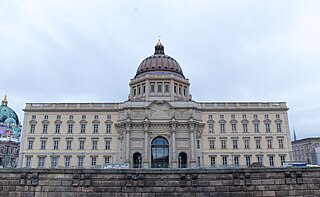 W
WThe Berlin Palace, formally the Royal Palace, on the Museum Island in the Mitte area of Berlin, was the main residence of the House of Hohenzollern from 1443 to 1918. Expanded by order of King Frederick I of Prussia according to plans by Andreas Schlüter from 1689 to 1713, it was thereafter considered a major work of Prussian Baroque architecture. The former royal palace was one of Berlin’s largest buildings and shaped the cityscape with its 60-meter (200 ft)-high dome.
 W
WCapernaum Church is one of the two places of worship of the Lutheran Capernaum Congregation, a member of the Evangelical Church of Berlin-Brandenburg-Silesian Upper Lusatia, an umbrella comprising Lutheran, Calvinist (Reformed) and united Protestant congregations. The church is located on Seestraße No. 34 in the locality of Wedding, in Berlin's borough of Mitte. The church was named after Capernaum, today Kfar Nachum כפר נחום in today's Israel.
 W
WThe synagogue on Fraenkelufer in Berlin's Kreuzberg district was built as an Orthodox Synagogue between 1913 and 1916 according to plans and under the direction of the master builder of the Jewish Community of Berlin, Alexander Beer. The structure was located on Kottbusser Ufer 48–50, today's Fraenkelufer 10-16. On Kristallnacht, the evening of November 9-10th, 1938, the main building of the synagogue was badly damaged. Further destruction in the following years led to the structures ultimate demolition in 1958/1959 after the end of World War II. Today the surviving outbuilding, previously used for the youth service, has been renovated and is home to a Conservative Synagogue. A complete reconstruction of the main synagogue that was destroyed by the National Socialists is being planned for its original location.
 W
WThe Franziskaner-Klosterkirche was a church in the Mitte district of Berlin, founded in 1250 and now in ruins.
 W
WSt. George's Church is an Anglican church in Berlin, Germany, a parish of the Diocese in Europe of the Church of England. The original building was erected on Monbijou Park in 1885, but during the Second World War was destroyed in allied bombings. The original site on Oranienburger Straße happened to be in what had become the Soviet sector of Berlin in 1945 and was therefore abandoned and the ruins removed in 1949. In 1950 the congregation built a new church on the corner of Preußenallee and Badenallee in Neu-Westend, part of the Westend locality of Berlin in the British sector. The church served as the garrison church of the British Army during the Allied occupation, and reverted to civilian control in 1994.
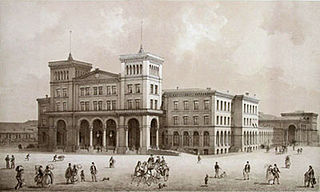 W
WGörlitzer Bahnhof was the name of the Berlin railway terminus for the mainline link between the capital, Cottbus in Brandenburg and Görlitz in Lower Silesia. It stood overlooking Spreewaldplatz in the Outer Luisenstadt, the eastern part of Kreuzberg but wartime bombing and Cold War tensions led to its closure and eventual demolition.
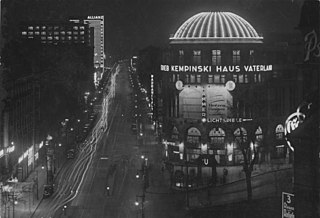 W
WHaus Vaterland was a pleasure palace on the southwest side of Potsdamer Platz in central Berlin. Preceded by Haus Potsdam, a multi-use building including a large cinema and a huge cafe, from 1928 to 1943 it was a large, famous establishment including the largest cafe in the world, a major cinema, a large ballroom and numerous theme restaurants, promoted as a showcase of all nations. It was partially destroyed by fire in World War II, reopened in a limited form until 1953, and was finally demolished in 1976.
 W
WSt. Hedwig's Cathedral is a Catholic church on Bebelplatz in the historic centre of Berlin. Dedicated to Hedwig of Silesia, it was erected from 1747 to 1887 by order of Frederick the Great according to plans by Georg Wenzeslaus von Knobelsdorff in Baroque style. Damaged during the Allied bombing in World War II, the cathedral of the Archdiocese of Berlin was restored from 1952 to 1963 in post-war modernist style as part of the Forum Fridericianum. Since 2018, the listed building has been closed for renovation.
 W
WHotel Bristol was a hotel on Unter den Linden in Berlin, Germany. It was designed by architect Gustav Georg Carl Gause and opened in 1891.
 W
WHotel Esplanade once stood on Berlin's busy transport and nightlife hub Potsdamer Platz. During its colourful and turbulent history it went from being one of the German capital's most luxurious and celebrated hotels to a bombed-out ruin lost in the wastelands alongside the Berlin Wall. A section of it still survives today, albeit as a fragment incorporated into the soaring modern complex of the Sony Center.
 W
WHotel Excelsior occupied number 112/113, Königgrätzer Straße on Askanischer Platz in the Berlin district of Kreuzberg. It was once one of the largest and most luxurious hotels in Europe but its destruction during World War II resigned it to the German capital's list of lost historical landmarks.
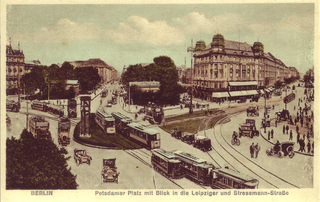 W
WHotel Fürstenhof was a hotel facing both Leipziger Platz and Potsdamer Platz in Berlin, Germany. It was designed by architects Richard Bielenberg and Josef Moser and opened in 1907. On 22 November 1943 the hotel was destroyed during a raid on Berlin; the ruins were completely demolished in the 1950s.
 W
WHotel Kaiserhof was a luxury hotel in Wilhelmplatz, Berlin, Germany. It opened in October 1875. It was located next to the Reich Chancellery in what was at the time the city's "government quarter".
 W
WJerusalem Church is one of the churches of the Evangelical Congregation in the Friedrichstadt, a member of the Protestant umbrella organisation Evangelical Church of Berlin-Brandenburg-Silesian Upper Lusatia. The present church building is located in Berlin, borough Friedrichshain-Kreuzberg, in the quarter of Friedrichstadt. Jerusalem Church is fourth in rank of the oldest oratories in the town proper.
 W
WThe Kaiser Wilhelm Memorial Church is a Protestant church affiliated with the Evangelical Church in Berlin, Brandenburg and Silesian Upper Lusatia, a regional body of the Evangelical Church in Germany. It is located in Berlin on the Kurfürstendamm in the centre of the Breitscheidplatz.
 W
WThe Kroll Opera House in Berlin, Germany, was in the Tiergarten district on the western edge of the Königsplatz square, facing the Reichstag building. It was built in 1844 as an entertainment venue for the restaurant owner Joseph Kroll, and redeveloped as an opera house in 1851. It also served as the assembly hall of the Reichstag from 1933 to 1942. Severely damaged by the bombing of Berlin in World War II and the Battle of Berlin, it was demolished in 1951.
 W
WThe Lessing Theater was a theatre in the Mitte district of Berlin, Germany. It opened in 1888 and was destroyed in April 1945 in a bombing raid; its ruins were demolished after World War II.
 W
WThe Luisenstädtische Kirche was a church building in Berlin, in the former Luisenstadt district, on Alte Jacobstraße between Sebastianstraße and Stallschreiberstraße. It was originally known as the Kirche in der Cöpenicker Vorstadt, then from 1785 to 1795 as the Köllnische Vorstadtkirche, then from 1795 to 1837 as the Sebastiankirche, after presbyter and city-councillor Sebastian Nethe, taking its final name in 1837.
 W
WMonbijou Palace was a Rococo palace in central Berlin located in the present-day Monbijou Park on the north bank of the Spree river across from today's Bode Museum and within sight of the Hohenzollern city palace. Heavily damaged in World War II, the ruins were finally razed by the communist authorities of East Berlin in 1959. The palace has not been rebuilt.
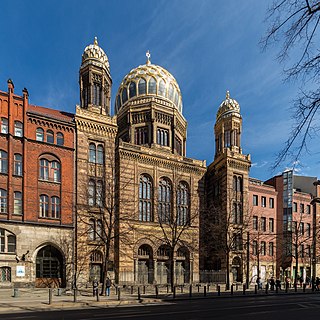 W
WThe New Synagogue on Oranienburger Straße in Berlin is a mid-19th century synagogue built as the main place of worship for Berlin's Jewish community, succeeding the Old Synagogue which the community outgrew. Because of its eastern Moorish style and resemblance to the Alhambra, the New Synagogue is an important architectural monument in Germany.
 W
WThe St. Nikolai-Kirche, is the oldest church in Berlin, the capital of Germany. The church is located in the eastern part of central Berlin, the borough of Mitte. The area around the church, bounded by Spandauer Straße, Rathausstraße, the River Spree and Mühlendamm, is known as the Nikolaiviertel 'Nicholas quarter', and is an area of restored medieval buildings. The church was built between 1220 and 1230, and is thus, along with the Church of Our Lady at Alexanderplatz not far away, the oldest church in Berlin.
 W
WThe Old Synagogue was a synagogue in the Berlin district of Marienviertel. Consecrated in 1714, it was known as the Great Synagogue until the opening of the New Synagogue, built in the 1860s to accommodate Berlin's expanding Jewish population. Nevertheless, services continued to be held in the Old Synagogue into the 20th century. The synagogue survived Kristallnacht but was destroyed during World War II.
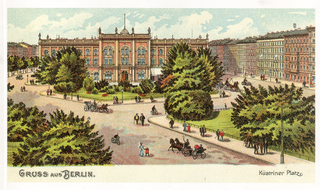 W
WThe old Berlin Ostbahnhof, sometimes also named Küstriner Bahnhof, was a short-lived passenger railway terminus in Berlin, Germany, opened on 1 October 1867 as the terminus of the Prussian Eastern Railway (Ostbahn) to Küstrin and Königsberg (Kaliningrad).
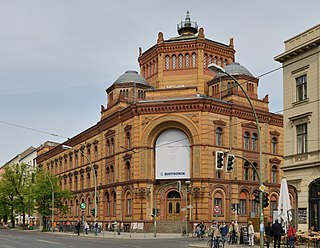 W
WPostfuhramt, formally known as Kaiserliche Postfuhramt is a historic building built in 1881 and located on Oranienburger Straße at the corner of Tucholskystraße, in the Spandauer Vorstadt area of Mitte, Berlin. Since 1975, it has been a listed as a protected building.
 W
WThe Potsdamer Bahnhof is a former railway terminus in Berlin, Germany. It was the first railway station in Berlin, opening in 1838. It was located at Potsdamer Platz, about 1 km south of the Brandenburg Gate, and kick-started the transformation of Potsdamer Platz from an area of quiet villas near the south-east corner of the Tiergarten park into the bustling focal point that it eventually became. For more than a century it was the terminus for long-distance and suburban trains. Also located at this spot were underground stations on the Berlin U-Bahn and S-Bahn, and today's new underground Regionalbahnhof, known as Bahnhof Potsdamer Platz, while the short-lived M-Bahn crossed the site of the former terminus.
 W
WThe Prinz-Albrecht-Palais was a Rococo city palace in the historic Friedrichstadt suburb of Berlin, Germany. It was located on Wilhelmstrasse 102 in the present-day Kreuzberg district, in the vicinity of Potsdamer Platz.
 W
WTrinity Church (Dreifaltigkeitskirche) was a Baroque Protestant church in Berlin, eastern Germany, dedicated to the Holy Trinity. It was opened in August 1739 and destroyed in November 1943, with its rubble removed in 1947.
 W
WThe Ufa-Palast am Zoo, located near Berlin Zoological Garden in the New West area of Charlottenburg, was a major Berlin cinema owned by Universum Film AG, or Ufa. Opened in 1919 and enlarged in 1925, it was the largest cinema in Germany until 1929 and was one of the main locations of film premières in the country. The building was destroyed in November 1943 during the Bombing of Berlin in World War II and replaced in 1957 by the Zoo Palast.
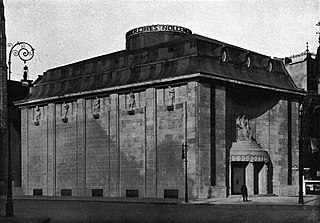 W
WThe Ufa-Pavillon am Nollendorfplatz was a cinema located at 4 Nollendorfplatz, Schöneberg, Berlin. Built in 1912–13 and designed and decorated by leading artistic practitioners of the day, it was the German capital's first purpose-built, free-standing cinema Described as "historically, [...] the most important cinema in Berlin", it incorporated a number of technical innovations such as an opening roof and a daylight projection screen, and opened as the Nollendorf-Theater in March 1913.